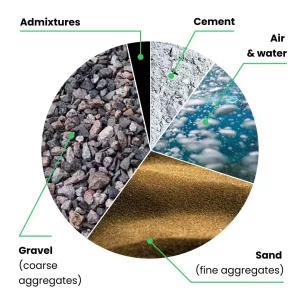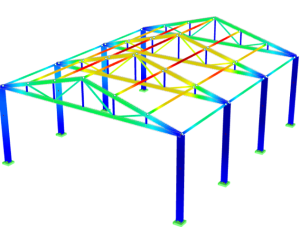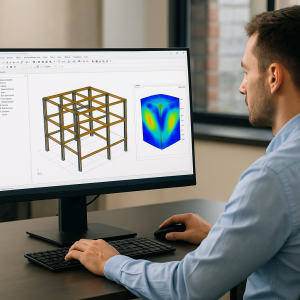Concrete is the backbone of modern infrastructure, from towering skyscrapers to expansive bridges and highways. However, traditional concrete production is one of the largest contributors to global carbon emissions, accounting for approximately 8% of the world’s CO₂ output. As the construction industry seeks greener alternatives, low-carbon concrete has emerged as a promising solution to reduce environmental impact without compromising performance.
In this article, we will explore the need for sustainable concrete, define what low-carbon concrete is, discuss the materials and production methods used, analyze its environmental benefits, examine applications in green building projects, and look at the challenges and future potential through a real-world case study.
The Need for Sustainable Concrete
Concrete’s widespread use has made it indispensable, but its environmental footprint cannot be ignored. The production of ordinary Portland cement (OPC), a key ingredient in concrete, is highly energy-intensive. It involves calcining limestone at temperatures exceeding 1400°C, releasing significant quantities of CO₂ both from the fuel combustion and the chemical decomposition of limestone (calcination).
With global urbanization accelerating, the demand for concrete is expected to rise, which could exacerbate environmental problems such as:
- Climate Change: Cement production contributes heavily to greenhouse gas emissions.
- Resource Depletion: High raw material consumption (limestone, sand, aggregates).
- Energy Consumption: High energy usage in cement manufacturing.
- Waste Generation: Construction and demolition waste related to concrete structures.
To meet international climate goals and sustainable development targets, the construction industry must adopt eco-friendly materials and methods, making sustainable concrete solutions like low-carbon concrete critical.
What is Low-Carbon Concrete?
Low-carbon concrete refers to concrete formulations and production techniques designed to significantly reduce the carbon footprint associated with traditional concrete. This can be achieved by:
- Using alternative cementitious materials with lower embodied carbon.
- Incorporating industrial by-products and recycled materials.
- Improving energy efficiency during production.
- Employing novel curing methods or admixtures to reduce cement content.
In essence, low-carbon concrete aims to deliver equivalent or improved mechanical and durability properties compared to conventional concrete but with a much lower environmental impact.

Materials and Production Methods
Supplementary Cementitious Materials (SCMs)
One of the most effective ways to reduce the carbon intensity of concrete is replacing a portion of Portland cement with SCMs such as:
- Fly Ash: A by-product from coal combustion in power plants.
- Ground Granulated Blast Furnace Slag (GGBFS): A by-product from steel manufacturing.
- Silica Fume: A by-product of silicon metal or ferrosilicon alloys production.
- Calcined Clays: Naturally occurring clays processed at moderate temperatures.
SCMs not only lower CO₂ emissions but can also improve concrete’s durability and strength.
Alternative Binders
Researchers are exploring alternatives to OPC binders, such as:
- Geopolymer Cement: Made from aluminosilicate materials activated by alkaline solutions.
- Magnesium-Based Cements: With lower calcination temperatures and potential CO₂ absorption during curing.
Carbon Capture and Utilization (CCU)
Innovative production methods include capturing CO₂ during manufacturing or curing and using it to cure concrete (carbonation curing), which permanently stores CO₂ within the concrete matrix.
Optimized Mix Designs
Advanced mix design techniques reduce the overall cement content by improving aggregate packing, using admixtures (plasticizers), and incorporating recycled aggregates.
Energy-Efficient Production
Reducing the energy consumed during cement grinding, transport, and mixing by optimizing processes and utilizing renewable energy sources further decreases the embodied carbon of concrete.
Environmental Impact Reduction
By incorporating the above methods, low-carbon concrete can reduce embodied carbon by 30% to 70% compared to traditional concrete, depending on the specific technologies and materials used.
Benefits include:
- Lower Greenhouse Gas Emissions: Significant reduction in CO₂ emissions from cement production.
- Reduced Resource Consumption: Utilizing industrial by-products minimizes the extraction of virgin materials.
- Waste Reduction: Recycling construction debris as aggregate helps close the material loop.
- Improved Lifecycle Performance: Longer-lasting concrete structures require less frequent repair and replacement, reducing long-term environmental impacts.
Applications in Green Building Projects
Low-carbon concrete is increasingly integrated into green building designs to achieve sustainability certifications such as LEED, BREEAM, and WELL. Common applications include:
- Foundations and Structural Elements: Use of SCMs in load-bearing walls, slabs, and columns.
- Precast Concrete Products: Reducing carbon footprint in precast panels and blocks.
- Infrastructure Projects: Bridges, tunnels, and roads built with optimized low-carbon mixes.
- Modular Construction: Facilitating efficient material use and waste reduction on-site.
- Decorative and Architectural Concrete: Combining sustainability with aesthetic demands.
Developers and engineers can achieve significant environmental credits by specifying low-carbon concrete, helping projects meet stringent sustainability goals.
Challenges in Scaling Low-Carbon Solutions
Despite the promise of low-carbon concrete, several challenges slow widespread adoption:
- Supply Chain Limitations: Availability of quality SCMs and alternative binders varies regionally.
- Performance Uncertainties: Concerns about long-term durability and mechanical properties under diverse conditions.
- Higher Initial Costs: Some low-carbon materials and technologies may have higher upfront costs, though lifecycle savings often offset this.
- Lack of Standardization: Variability in codes and standards makes design and approval processes more complex.
- Education and Training: Industry professionals require training on new materials and techniques.
- Regulatory and Market Barriers: Conservative procurement practices and limited incentives can hinder innovation.
Addressing these challenges requires collaboration between material scientists, engineers, policymakers, and industry stakeholders.
Case Study: Low-Carbon Concrete in Action
The Bullitt Center, Seattle, USA
Often referred to as the “greenest commercial building in the world,” the Bullitt Center incorporated low-carbon concrete as part of its sustainable design.
- Material Choices: The building used a mix with 50% fly ash replacement in its concrete, reducing embodied carbon significantly.
- Innovative Techniques: Carbonation curing was applied to some concrete elements, permanently sequestering CO₂.
- Performance: The low-carbon concrete achieved required strength and durability while supporting the building’s ambitious net-zero energy and water goals.
- Impact: The project demonstrated that low-carbon concrete can be integrated into demanding commercial construction without sacrificing performance or aesthetics.
This project serves as a benchmark for future green building initiatives worldwide.
Conclusion
Low-carbon concrete represents a critical advancement toward sustainable construction, addressing the urgent need to reduce carbon emissions in one of the most resource-intensive industries. By leveraging alternative materials, innovative production methods, and improved design approaches, low-carbon concrete offers an effective path to greener buildings and infrastructure.
While challenges remain in scaling and standardizing these solutions, ongoing research and successful projects like the Bullitt Center showcase the feasibility and benefits of adopting low-carbon concrete on a broad scale. The future of sustainable construction depends on embracing such innovations to build resilient, eco-friendly communities for generations to come.




